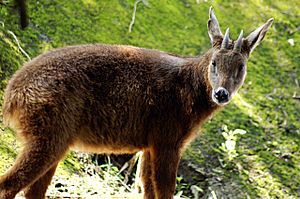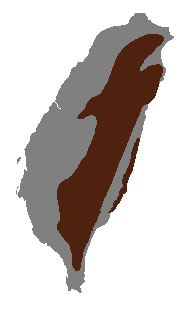Taiwan serow facts for kids
Quick facts for kids Taiwan serow |
|
|---|---|
 |
|
| Conservation status | |
| Scientific classification | |
| Genus: |
Capricornis
|
| Species: |
swinhoei
|
 |
|
| Distribution of Formosan serow | |
| Synonyms | |
|
Naemorhedus swinhoei |
|
The Taiwanese serow (Capricornis swinhoei), also called the Formosan serow, is a small, goat-like animal. It belongs to the bovid family, which includes animals like cows, goats, and sheep. This special animal is found only in Taiwan, meaning it is endemic there.
Contents
What Does a Taiwanese Serow Look Like?
Size and Appearance
Taiwanese serows are not very big. They are about 80 to 114 centimeters (around 2.5 to 3.7 feet) long from head to body. They usually weigh between 25 and 35 kilograms (about 55 to 77 pounds). Their tail is quite short, only about 6.5 centimeters long.
Their fur is a dark tan color. They have cool yellow spots on their jaw, throat, and the back of their neck.
Horns and Unique Features
Both male and female serows have horns. These horns curve a little bit backward and can be 10 to 20 centimeters long. They are shaped like cones and, unlike deer antlers, they never fall off. The Formosan serow is the only native bovid animal living in Taiwan.
How Do Taiwanese Serows Live?
Daily Life and Diet
Taiwanese serows are very shy and careful animals, so they are hard to spot in the wild. However, you can often find their droppings in places like Yushan National Park. They usually eat alone or in small groups during the early morning and late evening.
They mostly munch on leaves that are below their shoulder height. They also eat vines, ferns, shrubs, and other plants found on the ground. Serows also need salt, so they sometimes lick minerals off cliffs or rocks.
Amazing Abilities and Habitat
These serows are incredible jumpers! They can leap as high as 2 meters (about 6.5 feet). They are also super fast, able to run up to 55 kilometers per hour (about 34 miles per hour). Among all the mammals in Taiwan, they are the best high jumpers.
You can find them in many different places, from as low as 50 meters above sea level to as high as 3500 meters. They prefer forests with conifer trees, mixed forests, and even steep, rocky cliffs. They have been seen on top of famous mountains like Nanhu Mountain, Hsuehshan, Yushan, and Siouguluan Mountain. They also live in Taroko National Park.
Their hooves can spread apart, which helps them grip rocks easily on steep slopes. They are even good at climbing trees! Taiwanese serows like to live by themselves and protect their own territory. They use tears to mark branches or stones, letting other serows know that area is taken.
Reproduction and Life Cycle
Mating and Birth
Taiwanese serows usually mate between September and November. After mating, the mother serow carries her baby for about seven months. Calves are born between March and June of the next year.
Most of the time, a mother serow gives birth to one calf, but sometimes she can have twins. Newborn calves are amazing – they can stand up on their own just a few hours after being born!
Growing Up
When calves are about three months old, they can start finding food by themselves. However, their mothers will still nurse them. Male serows do not help take care of the calves.
Between six months and one year old, the young serows slowly start to live on their own, separate from their mothers. They become old enough to have their own babies when they are two to three years old. Taiwanese serows can live for about 15 years.
Protection and Predators
Protected Status
Since 1989, the Taiwanese serow has been listed as a rare and valuable species. This means they are protected by Taiwan's Cultural Heritage Preservation Act, a law that helps protect important cultural and natural things. The biggest dangers to the Taiwanese serow are losing their homes (habitat destruction) and being hunted.
Natural Enemies
There are not many animals that hunt serows in Taiwan. The main predator is the Formosan black bear. Sadly, another animal that used to hunt them, the Formosan clouded leopard, is now extinct.
See also
- List of protected species in Taiwan
- List of endemic species of Taiwan


